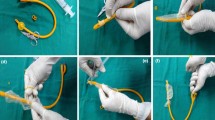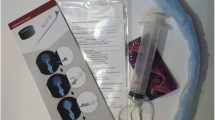Abstract
Introduction
Conventionally postpartum hemorrhage (PPH) has been defined as blood loss of more than 500 ml following vaginal delivery and 1000 ml following a cesarean section [Pritchard et al. in Am J Obstet Gynecol 84(10):1271–1282, (1962)]. Another definition labels PPH as any blood loss which causes a 10 % drop in hematocrit [Combs et al. in Obstet Gynecol 77:69–76, (1991)] or which threatens the hemodynamic stability of the patient and necessitates blood transfusion [Prendiville et al. in Cochrane Database Syst Rev 2:CD000007, (2000)]. The purpose of this study was to evaluate the effectiveness of condom tamponade in the management of massive obstetric hemorrhage.
Objective
To evaluate the efficacy of a condom as a tamponade for intrauterine pressure to stop massive PPH.
Methods
This prospective study was done in the Obstetrics and Gynecology Department of NIMS Medical College and Hospital, Jaipur, between December 2013 and February 2015. With aseptic precautions, a sterile rubber catheter fitted with a condom was introduced into the uterus. The condom was inflated with 250–500 ml normal saline according to need. Vaginal bleeding was observed, and further inflation was stopped when bleeding ceased.
Results
In all but 2 (94.44 %) the cases, postpartum bleeding was stopped within 10 min of creation of tamponade. On an average, 350 ml of normal saline was required to create adequate tamponade to stop the bleeding.
Conclusion
Use of condom tamponade can effectively help in reducing both maternal morbidity and mortality associated with PPH. Our study encourages use of condom tamponade which is efficient, cost-effective, easily available and requires lesser skills as compared to the traditional surgical procedures.
Similar content being viewed by others
References
Pritchard J, Baldwin R, Dickey J, et al. Blood volume changes in pregnancy and the puerperium. Am J Obstet Gynecol. 1962;84(10):1271–82.
Combs C, Murphy E, Laros R. Factors associated with postpartum hemorrhage and vaginal births. Obstet Gynecol. 1991;77:69–76.
Prendiville W, Elbourne D, Mc Donald S. Active versus expectant management in the third stage of labor. Cochrane Database Syst Rev. 2000;2:CD000007.
Hayman RG, Arulkumaran S, Steer PJ. Uterine compression sutures: surgical management of postpartum haemorrhage. Obstet Gynaecol. 2002;99:502–6.
Vangsgaard K. “B-Lynch-suture” in uterine atony. Ugeshr-Laeger. 2000;162:3468.
El-Rafaey H, Charles R. Postpartum hemorrhage: definitions, medical and surgical management. A time for change. Br Med Bull. 2003;67:20517.
Maine D, Rosenfield A, Wallis M. Prevention of maternal death in developing countries. New York: The Center for Population of Family Health; 1999.
Akhter S, Begum MR, Kabir Z, et al. Use of a condom to control massive postpartum hemorrhage. Posted: September 11, 2003. Medscape General Medicine. 2003;5(3) © 2003 Medscape.
Yorifuji T, Tanaka T, Makino S, et al. Balloon tamponade in atonic bleeding induces uterine contraction: attempt to quantify uterine stiffness using acoustic radiation force impulse elastography before and after balloon tamponade. Acta Obstet Gynecol Scand. 2011;90(10):1171–2.
Drshivkar’s Blog. ‘SHIVKAR’s PACK’. N.p., 2011. Web. 27 Aug. 2015.
World Health Organisation (WHO). The World Health Report 2005: make every mother and child count. Geneva: WHO Press; 2005. (Cited on March 25). http://www.who.int/whr/2005/en/index.html.
Evensen A, Anderson J, Chapter J. Postpartum hemorrhage: third stage pregnancy. 2013: e1–e20. (Cited on April 4, 2014). http://www.aafp.org/dam/AAFP/documents/about_us/initiatives/also-blso/also_syllabus/chapterj-postpartum-hemorrhage.pdf.
Acknowledgments
Special thanks to Dr. Pallavi Rathod, Dr. Raksha Sharma, Dr. Shilpa Gupta, Dr. Sumedha Aggarwal and Nessy John.
Author information
Authors and Affiliations
Corresponding author
Ethics declarations
Conflict of interest
Dr. Rakesh Hasabe, Dr. Kumud Gupta and Dr. Pallavi Rathode declare that they have no conflict of interest.
Human and Animal Rights
This article does not contain any studies with human or animal subjects.
Additional information
Dr. Rakesh Hasabe is a MBBS from RCSM GMC, Kolhapur, second year of DNB at NIMS University, Jaipur; Dr. Kumud Gupta is a Associate Professor of NIMS University Jaipur; Dr. Pallavi Rathode is a MBBS from RCSM GMC, Kolhapur.
Rights and permissions
About this article
Cite this article
Hasabe, R., Gupta, K. & Rathode, P. Use of Condom Tamponade to Manage Massive Obstetric Hemorrhage at a Tertiary Center in Rajasthan. J Obstet Gynecol India 66 (Suppl 1), 88–93 (2016). https://doi.org/10.1007/s13224-015-0790-x
Received:
Accepted:
Published:
Issue Date:
DOI: https://doi.org/10.1007/s13224-015-0790-x




